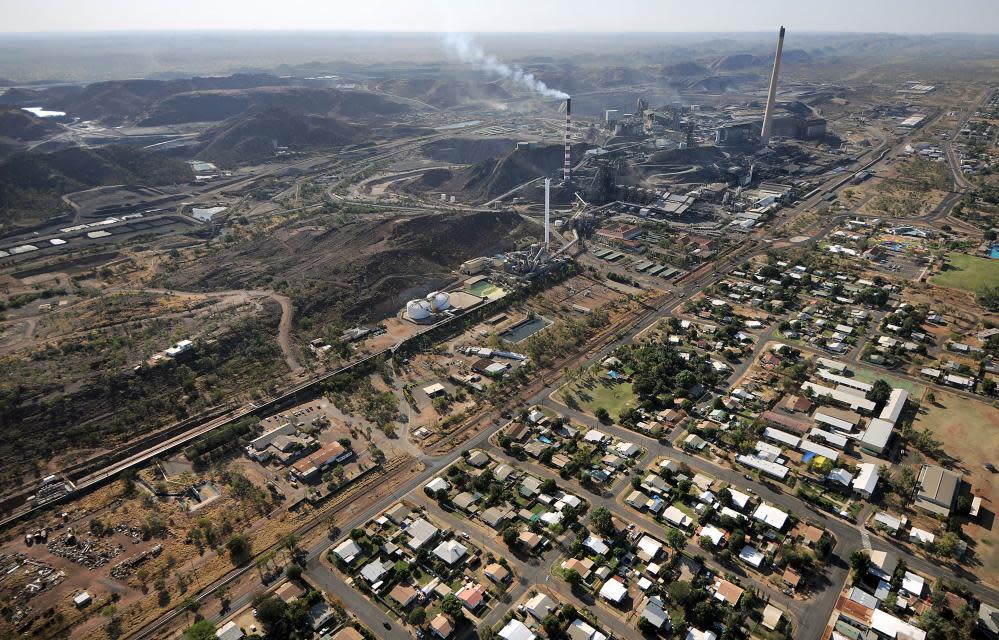Australian Conservation Foundation names Mount Isa the most polluted postcode in the country

Mount Isa has been named the most polluted postcode in Australia in a new report from the Australian Conservation Foundation (ACF).
The ACF said the outback city is one of four Queensland locations listed among the Top 10 most polluted postcodes in the country, alongside Gladstone, Stanwell and Tarong.
The report was based on analysis of five pollutants of concern in the National Pollutant Inventory: sulfur dioxide, mercury, coarse and fine particles and oxides of nitrogen.
Mount Isa hosts copper, lead, zinc and silver mines, with 17 facilities reporting pollutants of concern to the NPI.
Mines in around the city emitted 400,000 tonnes of sulfur dioxide, 3,800 tonnes of oxides of nitrogen and 860kg of mercury and compounds in the air in the 2020/21 reporting period, according to the NPI.
Local residents told Guardian Australia that when they take their children to play at the local park, they can sometimes taste the sulfur dioxide blowing in from the copper smelter nearby.
They also spoke of one occasion where a school assembly finished early because children were coughing due to fumes drifting into the grounds from a nearby mine.
One resident – a former school teacher in the town, who did not wish to be named – said she decided to move away from Mount Isa last year when she fell pregnant.
As an asthmatic, she said remembers times where she had to cover her mouth and nose while walking between buildings at work.
Mount Isa Mines, operated by Glencore, is responsible for 91% of the postcode’s emissions, according to the ACF.
Glencore said Mount Isa Mines has the “most intensive air quality monitoring network of any city in Australia”, as part of an “industry-leading” framework used to control emissions and dust at the source and prevent contaminates from escaping.
“Mount Isa Mines is regulated by over 75 separate permits and authorities, with stringent and transparent reporting of environmental performance and we operate within our environmental limits for sulphur dioxide emissions and lead,” the company said.
“Every resident of Mount Isa is within 1,200 metres of a sulphur dioxide monitor. Mount Isa Mines also engages openly about operations to ensure the community and stakeholders can stay informed.”
Matthew Rose, ACF’s economy and democracy program manager, said sulfur dioxide is associated with “increased respiratory symptoms, difficulty in breathing and ultimately, for some people, premature death.”
“Air pollution kills about 3,000 Australians every year and worsens conditions such as asthma, emphysema, chronic bronchitis and other respiratory diseases,” Rose said.
Related: ‘Is it all worth it?’: farmers left heartbroken as Queensland floods ruin crops
But he said Mount Isa was one of the few “polluted” postcodes in the country that does not host coal-fired power stations or coalmines.
Muswellbrook in the New South Wales Hunter Valley, Traralgon in Victoria’s Latrobe Valley, Collie in Western Australia and Queensland’s Gladstone, Stanwell and Tarong are all centres for coal burning, according to the ACF.
Danielle Slade, the mayor of Mount Isa, said Glencore has a comprehensive system of emission capturing technology in place.
“They probably have one of the most intense air monitoring networks in any city in Australia. It operates 24/7,” Slade said.
Slade said the city’s copper smelter has an acid plant attached to it that captures all the fumes coming out of the stack. She said the copper smelter’s emissions are then turned into fertiliser.
“There are some good, sort of green ways to turn to manage this,” she said. “Mining of these minerals is critical so that we can have electric cars, smartphones, smart TVs.”
Slade acknowledged it was “very rare” to have a community living so close to a mine, but described moments where residents can taste sulfur as “isolated incidents” that occur only when the acid plant was down.
“I grew up in Mount Isa and before the acid plant was here you could taste the sulfur. The mine’s been doing a great job to mitigate this,” she said.
Queensland’s environment minister, Meaghan Scanlon, said the Environment Department “takes air quality very seriously and plays an active role in monitoring air quality across Queensland”.
“Right now, the department reports and monitors close to 40 monitoring stations throughout Queensland, including in Mount Isa and in Gladstone, where we have installed eight monitoring stations,” Scanlon said.
Scanlon said overall air quality has improved over the last three decades and remains “relatively good as a result of industry regulation, stricter emission standards for motor vehicles and new emission reduction technology.”
But Rose said Australia needs new, nationally consistent air quality standards and a coherent national plan to transition to a clean energy future.

 Yahoo Movies
Yahoo Movies 
